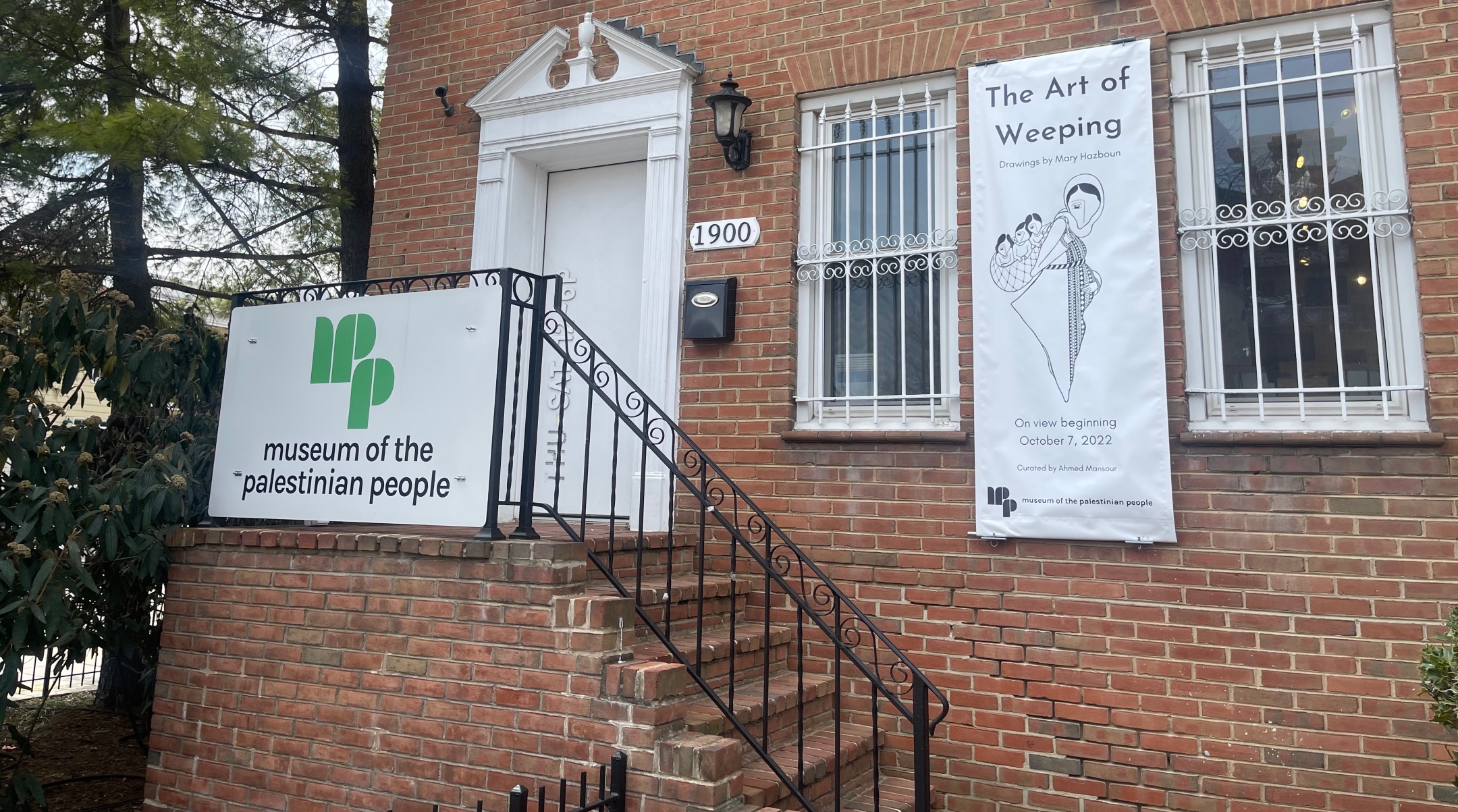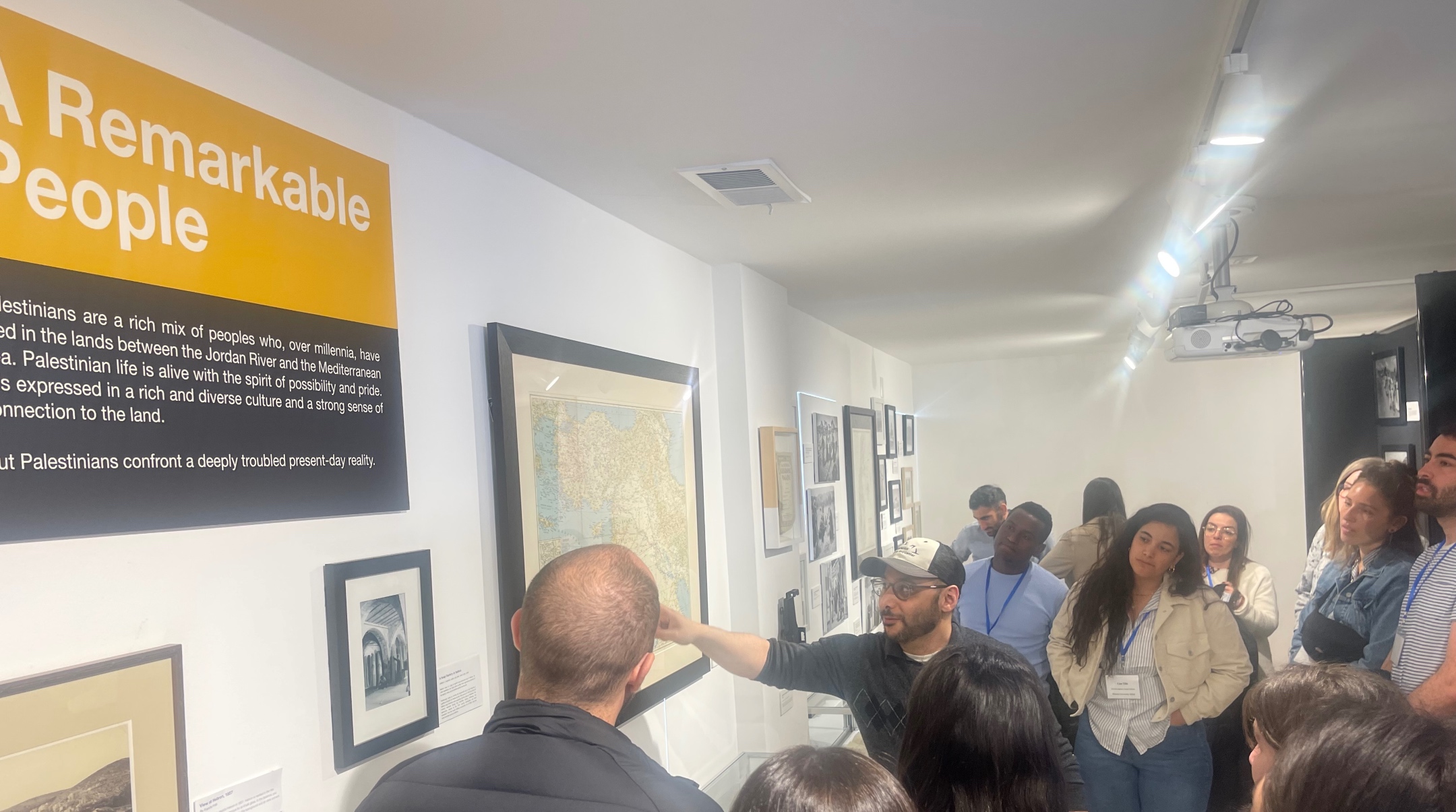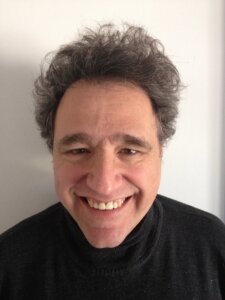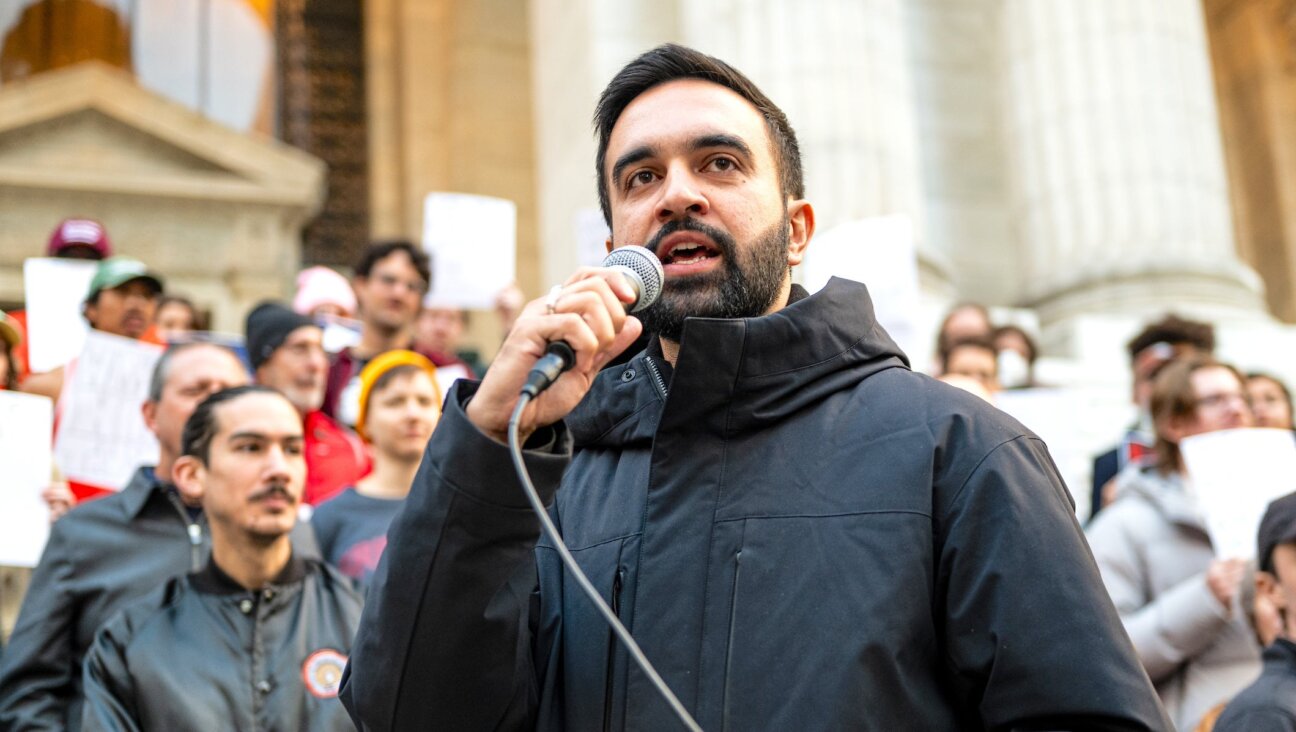A group of Israeli emissaries toured a Palestinian museum in DC, and came away with questions
Emissaries trained to celebrate Israel’s existence examine exhibits that mourn the circumstances of its founding

The Museum of the Palestinian People in downtown Washington DC, March 22, 2023. (Ron Kampeas)
WASHINGTON (JTA) — For Rotem Yerushalmi, a professional campus pro-Israel advocate, what stood out during a recent visit to the Museum of the Palestinian People was an exhibit showcasing different villages’ ceremonial dress.
She strolled past references to the Nakba, which means “catastrophe” and denotes the dispersion of Palestinians during Israel’s War of Independence. And she gazed upon a photograph of an elderly man clutching the key to the dwelling his family left amid that year’s Arab-Israeli war. None of those surprised her.
“The references to the key, the Nakba, were very familiar,” Yerushalmi said. “But the garb! I didn’t know they had different dresses for different areas.”
Yerushalmi was part of a delegation of about 20 Israeli emissaries stationed at U.S. universities that visited the museum late last month. It was the first-ever tour the museum had organized for a group of Israelis.
Like most Jews in Israel, many of them had relatively few interactions with Arabs inside the country, and learned little about Palestinian culture and history in school. But here at the Washington museum, located just a mile from Yerushalmi’s post at Georgetown University, they got a view into a society that is both largely off-limits to them and entwined with their country’s future.
“It’s important because it humanizes each other, I think, for Israelis to hear the Palestinian perspective,” said Bshara Nassar, a Palestinian from Bethlehem who founded the one-room museum in 2019. “Actually having a wall that separates Palestinians from Israelis — there is no way, there is no place to interact.”
The tour was the brainchild of Jonathan Kessler, the former longtime head of student affairs at the American Israel Public Affairs Committee, the pro-Israel lobby. He now helms Heart of a Nation, which organizes people-to-people encounters between young Israelis, Palestinians and Americans — and which marks a turn away from the pro-Israel advocacy he once championed.
“For the first time, maybe in my lifetime, you’ve got young people from all three societies who simultaneously recognize that their politics is stuck and they desperately want to push forward into a better place,” he told the Jewish Telegraphic Agency.
He worries that unless they move beyond their “narrow communal silos,” young Jews in the United States “will further distance themselves from Israel, young Israelis will turn their back on the pursuit of peace with the Palestinians, and young Palestinians will give up on coexistence with Israel.”
Recommending a tour of the museum, he said, was a way to make that happen. The Jewish Agency for Israel’s Campus Israel Fellows, which brought the emissaries to Washington, D.C., asked him to recommend museum tours for the group, and he suggested the U.S. Holocaust Memorial Museum, the National Museum of African American History and this tiny, barely known institution.

Mohammed El-Khatib, a docent at the Museum of the Palestinian People, leads a group of Jewish Agency emissaries through the museum in Washington, D.C., March 22, 2023. (Ron Kampeas)
Another perspective
For at least some of the emissaries, the visit had Kessler’s intended effect. Mohammed El-Khatib, the group’s docent, described his experience as a Lebanese-born Palestinian refugee, and told of his family’s flight from their ancestral village during Israel’s War of Independence.
“It opens our mind to hear his perspective, to hear him say that he’s Palestinian, but he’s never been to Palestine, he was born in Lebanon, but he identifies as a Palestinian,” said Lielle Ziv, who works at Cleveland Hillel. “He told a story, and not like, right or wrong, it’s not a black-and-white situation. We can both be right,”
The museum is nestled in a townhouse adjacent to a pet care outlet, a Middle East bookstore and a chocolatier. A similar and larger museum in the Palestinian West Bank city of Birzeit, called the Palestinian Museum, is in territory that is off-limits to Israelis.
At the Washington museum, there was a lot of common ground: A Kurdish Israeli emissary said the keffiyeh in one exhibit reminded him of pictures of his male relatives, who wore similar headdresses before they left Iraq for Israel. El-Khatib was pleased to learn that the Arabic name for Hebron, Al Khalil, has the same meaning as the city’s Hebrew name — a “friend of God.”
One of the Israelis recognized the British Mandate passport on display, which once belonged to a Palestinian woman. His grandmother had one that was identical, he said.
When El-Khatib greeted the group, he said “Marhaba, Shalom,” respectively the more formal Arabic and Hebrew terms of welcome, and the group spontaneously answered with “Ahalan,” a less formal Arabic greeting that is commonplace among Israelis. That delighted El-Khatib.
The group was similarly pleased when he showed off some Hebrew phrases in a pitch perfect Israeli accent, which he said he learned from an Israeli ex-boyfriend. The group then pushed him to spill more details about his ex.
“In campus encounters we’re always kind of on duty,” said Nati Szczupak, the director of the Campus Israel Fellows program. “They’re on duty, right? They’re pro-Palestine. We’re pro-Israel. And it’s very rare that you can just talk and get to those moments of like, ‘Hey, I used to wear that hat too, when I was little.’”
She was referring to an exhibit on different types of Palestinian headwear that included a fez, or traditional Moroccan hat, which elicited a squeal of delight from a Moroccan Jewish emissary who said she had a photo of herself as a toddler sporting one of her ancestors’ fezzes.
“It’s not about facts,” Szczupak said. “We know the facts. What about the narrative? What is your story? We’re not arguing about the facts, but how we experienced them.”
Art and politics
The museum’s exhibits include photographs of Palestinians in Israel, the West Bank and in exile, and are marked by contrasts: images of resistance — of a small boy throwing stones — and of the mundane — of young men playing soccer. Arrays of black-and-white photos from the late 19th and 20th centuries feature celebrations juxtaposed with resettlement in refugee camps.
A case includes Palestinian glassware, pottery and headwear throughout the ages. There was a temporary exhibit of line drawings by a contemporary Palestinian artist, and a wall titled “Making their mark” of prominent Palestinians — including Rashida Tlaib, the Democratic congresswoman from Michigan; the late Edward Said, the literary critic and scholar; the sisters Gigi and Bella Hadid, who are models; and DJ Khaled, the rapper.
The museum does not hold back from addressing the Israeli-Palestinian conflict. The conflict’s most vexing issue — each side’s fear that the other side wants to replace it — was most evident in the museum’s maps: One depicted the scattering of the Palestinians throughout the Diaspora, and others showed how Israel expanded its territory from the land it was given in the 1947 United Nations partition plan.
Outside the museum, while the Israelis were waiting for the tour to start, a pair of the Israel fellows examined a poster for an exhibit, “The Art of Weeping, by a Palestinian artist, Mary Hazboun. The line drawing of a Palestinian mother in a traditional dress, carrying her babies, evoked the map of the entirety of Israel, Gaza and the West Bank — and then some.
“The proportions are interesting,” one said to the other, in Hebrew. “It includes not just Israel and the West Bank and the Gaza Strip, but the Golan Heights and a part of Jordan.”
Ziv said the tour made her think that she “would like more connections” with Palestinians — and it was clear that it was easier to make those connections in Washington than it would be in Tel Aviv or Jenin. El-Khatib said he had never met an Israeli before he moved to the United States.
“When we have Palestinian visitors coming to the museum, they quickly doze off — I mean, to them, it’s more about the achievement of the space,” El-Khatib said. “But when this group came in, I really felt that they were very attentive and hanging on to every word that I said, which was wonderful.”
This article originally appeared on JTA.org.























